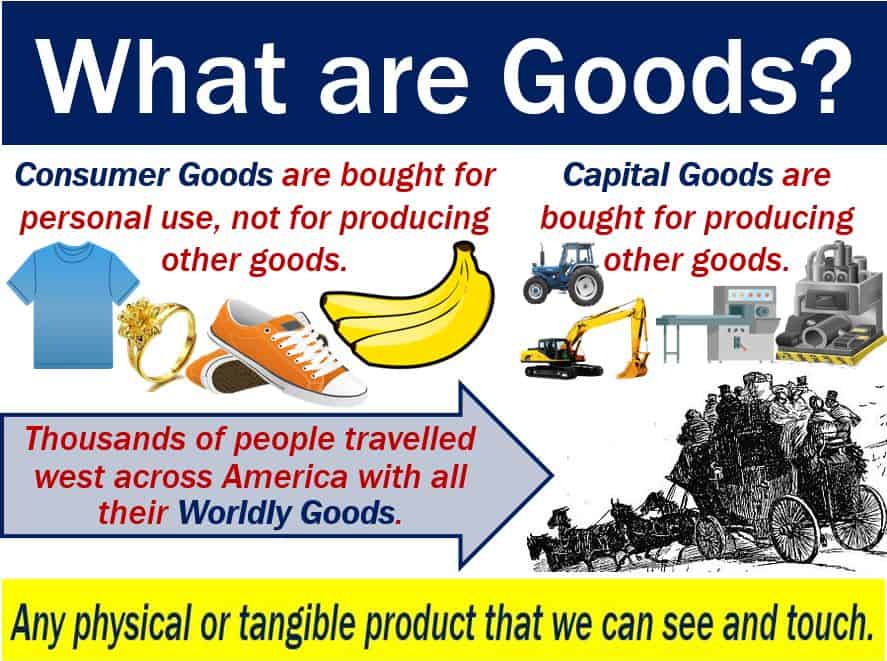Goods are products, i.e., things that we make or grow and aim to sell. For example, we can exchange money for goods and services. The term also refers to one’s possessions; the things we own. For example “All my worldly goods would fit into that bag.”
We usually use the term when we refer to items that we can move.
Although we generally use the term in its plural form, we can also use the singular form ‘good.’ A ‘good’ is a product.
Economists say that the term refers to materials that satisfy human wants. They also provide utility, for example, to a shopper who buys a satisfying product.
The term refers to physical things, as opposed to services, which are abstract or non-physical. For example, laptops and smartphones are goods, while lawyers and travel agents provide services.
In today’s global economy, goods often cross multiple borders and change hands several times before reaching the consumer, highlighting the interconnectedness of international trade.
When talking about transportation, the term refers to cargo, rather than passengers. For example, a goods train transports things, not people.

Excludable and rivalrous
In economics, we can categorize goods in several different ways. There are two may categories – excludable and rivalrous.
Excludable
If people can be prevented from consuming something, for example, if they have not paid, it is excludable.
To consume an apple I need to buy it, i.e., I need to pay for it. Therefore, if I do not pay, I cannot have it.
Non-excludable items also exist. For example, tap water is non-excludable. Anybody can turn on a tap and consume water. It is not possible to direct the water to just some consumers.
Even if somebody has no access to water at home, they can walk into a supermarket toilet and turn on the tap.
Rivalrous
A rivalrous good is one that consumers ‘use up’ when they consume it, i.e., others cannot consume that thing.
If I buy a pint of milk and then drink it, nobody else can consume that pint of milk. They cannot consume that milk because it no longer exists, i.e., somebody has consumed it.
Some products are non-rivalrous. If I create a great work of art, i.e., a painting, it is not rivalrous. It is not possible to ‘use it up’ so that nobody else can enjoy it. An unlimited number of people can see and enjoy it.
So, how can we categorize the different types of things below?
Private Goods
These are products that we must buy if we want to consume them. If one person buys it, that prevents somebody else from consuming that particular item. Private goods are rivalrous and excludable.
Open-access common property
For example, the fish in the sea, the air we breathe, and sunlight are open-access common property.
However, when I catch and consume a fish, there is less for other people. Open-access common property is rivalrous and non-excludable.
Public goods
Pollution free air, national defense, and street lighting are examples of things that are available to the public. Economists say that they are non-rivalrous.
Access to impure public goods can become a problem if too many people try to use them. For example, a congested road is not accessible to people who want to drive through it.
What are capital goods?
These are things we use to produce things. They last a long time, i.e., they are durable. Examples include vehicles, computers, machinery, etc. The term may also refer to infrastructure items such as bridges, roads, and railway lines.
We use the term when talking about the creation of productive capacity and capital formation.
What are intermediate goods
Intermediate goods are products that we use in the production process of a final product.
For example, a baker’s final product is bread. Bakers buy salt, which they add to the flour when making bread. They then sell the bread. Therefore, salt is an intermediate good. Put simply, an intermediate good is either a component or ingredient of a final product.
Capital vs. intermediate goods
A capital good differs from an intermediate good, even though we use both to make something else. A baker’s oven is a capital good because it is necessary in the production of bread. However, the oven is not an ingredient of bread.
Salt, on the other hand, is an ingredient. Therefore, salt is an intermediate good.
What are consumer goods?
Consumer goods are products that consumers buy and consume. We buy them for our own use. We do not make other things with them that we then sell. We also call them final goods.
Consumer vs. intermediate goods
If I buy salt and take it home for my family and I to consume, it is a consumer good. However, when the baker buys it to make bread, which is then sold, it is an intermediate good.
What are Giffen goods?
These are products which sell better when their prices go up. This is the opposite to what happens to most products. Usually, when prices rise, demand for most things goes down.
The term usually refers to staple products, i.e., inferior products, such as bread or rice.
In Victorian England, for example, bread was the staple food for poor people. If the price of bread rose, poor households were unable to switch to alternative products.
Meat was very expensive, so poor people ended up buying even more bread, and less meat. If the amount you are spending on your basic foodstuff rises, this means you have less to spend on other foods. Therefore, you must buy more of the basic foodstuff to get the necessary daily calories.
Household goods are products that we buy to use inside our homes. This category also includes clothes, but not real estate, vehicles, or boats.
Contrary to Giffen goods, luxury items often see a decrease in consumption as their prices rise, demonstrating a typical response to price changes in the market.
